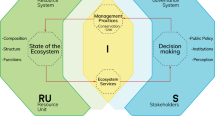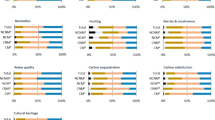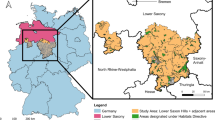Abstract
Changes in forest land use and management arise from the decisions of individual forest owners. To gain a better understanding of forest owner decision-making and its implications for forest land-use change, we develop a forest owner functional typology based on a meta-analysis of quantitative and qualitative information about forest owners and their decision-making strategies across the developed world. From this typology, we develop an index of forest owner sustainability. We find nine broad forest owner functional types: industrial productionist, non-industrial productionist, for-profit recreationist, for-profit multi-objective, non-profit multi-objective, recreationalist, species conservationist, ecosystem conservationist and passive owner. These owner types align along three gradients representing (1) their economic focus, (2) the intensity of their management practices and (3) the type of goods and services they provide (private vs. public). We also find that multi-objective and conservationist owners generally practise the most sustainable forms of forest management and industrial productionists the least sustainable in terms of triple bottom line sustainability. Supracontinental land owner typologies of this kind can be useful in assisting international policy making and in developing resource management programmes. We suggest that future studies should investigate forest owner typologies in the developing world, forest owner information-sharing networks, and the ways in which forest owners learn and adapt to environmental change.


Similar content being viewed by others
Notes
Global refers here not to worldwide, but to international or supra-continental.
References
Andersson M (2012) Assessing non-industrial private forest owners’ attitudes to risk: do owner and property characteristics matter? J For Econ 18:3–13. doi:10.1016/j.jfe.2011.05.001
Arano KG, Munn IA (2006) Evaluating forest management intensity: a comparison among major forest landowner types. Forest Policy Econ 9:237–248. doi:10.1016/j.forpol.2005.07.011
Arneth A, Brown C, Rounsevell MDA (2014) Global models of human decision-making for land-based mitigation and adaptation assessment. Nat Clim Chang 4:550–557. doi:10.1038/nclimate2250
Arnold JEM, Perez MR (2001) Can non-timber forest products match tropical forest conservation and development objectives? Ecol Econ 39:437–447. doi:10.1016/s0921-8009(01)00236-1
Baker AM, Lacy RC, Leus K, Traylor-Holzer K (2011) Intensive management of populations for conservation. WAZA Mag 12:40–43
Beach RH, Pattanayak SK, Yang JC, Murray BC, Abt RC (2005) Econometric studies of non-industrial private forest management a review and synthesis. Forest Policy Econ 7:261–281. doi:10.1016/s1389-9341(04)00065-0
Beratan KK (2007) A cognition-based view of decision processes in complex social-ecological systems. Ecol Soc 12:27
Boon TE, Meilby H, Thorsen BJ (2004) An empirically based typology of private forest owners in Denmark: improving communication between authorities and owners. Scand J For Res 19:45–55. doi:10.1080/14004080410034056
Canadas MJ, Novais A (2014) Bringing local socioeconomic context to the analysis of forest owners’ management. Land Use Policy 41:397–407. doi:10.1016/j.landusepol.2014.06.017
Caughley G (1994) Directions in conservation biology. J Anim Ecol 63:215–244. doi:10.2307/5542
Cocklin C, Dibden J, Mautner N (2006) From market to multifunctionality? Land stewardship in Australia. Geogr J 172:197–205. doi:10.1111/j.1475-4959.2006.00206.x
Creighton J, Baumgartner D, Blatner K (2002) Ecosystem management and nonindustrial private forest landowners in Washington State, USA. Small Scale Econ Manag Policy 1:55–69. doi:10.1007/s11842-002-0005-z
Duncker PS, Barreiro SM, Hengeveld GM, Lind T, Mason WL, Ambrozy S, Spiecker H (2012) Classification of forest management approaches: a new conceptual framework and its applicability to European forestry. Ecol Soc 17:51. doi:10.5751/es-05262-170451
Eggers J, Lamas T, Lind T, Ohman K (2014) Factors influencing the choice of management strategy among small-scale private forest owners in Sweden. Forests 5:1695–1716. doi:10.3390/f5071695
Elkington J (1994) Towards the sustainable corporation—win-win-win business strategies for sustainable development. Calif Manag Rev 36:90–100
Emtage N, Herbohn J, Harrison S (2007) Landholder profiling and typologies for natural resource-management policy and program support: potential and constraints. Environ Manag 40:481–492. doi:10.1007/s00267-005-0359-z
Eriksson L (2012) Exploring underpinnings of forest conflicts: a study of forest values and beliefs in the general public and among private forest owners in Sweden. Soc Nat Resour 25:1102–1117. doi:10.1080/08941920.2012.657749
FAO (2000) The global outlook for future wood supply from forest plantations. FAO, Rome
FAO (2005) Trends in wood products 1961–2003. FAO, Rome
FAO (2012) Global forest products products facts and figures. http://www.fao.org/forestry/en/. Accessed 28 March 2014
Ferber J (1999) Multi-agent systems: an introduction to distributed artificial intelligence. Addison-Wesley Longman, Harlow
Ficko A, Boncina A (2013) Probabilistic typology of management decision making in private forest properties. Forest Policy Econ 27:34–43. doi:10.1016/j.forpol.2012.11.001
Finley AO, Kittredge DB (2006) Thoreau, Muir, and Jane Doe: different types of private forest owners need different kinds of forest management. North J Appl For 23:27–34
Franklin JF (1993) Preserving Biodiversity: species, Ecosystems, or Landscapes? Ecol Appl 3:202–205. doi:10.2307/1941820
Fujimori T (2001) Ecological and silvicultural strategies for sustainable forest management. Elsevier, Amsterdam
Gamfeldt L et al (2013) Higher levels of multiple ecosystem services are found in forests with more tree species. Nat Commun 4:1340. doi:10.1038/ncomms2328
Griliches Z, Mason WM (1972) Education, income, and ability. J Polit Econ 80:S74–S103. doi:10.2307/1831252
Guillem EE, Barnes AP, Rounsevell MDA, Renwick A (2012) Refining perception-based farmer typologies with the analysis of past census data. J Environ Manag 110:226–235. doi:10.1016/j.jenvman.2012.06.020
Ingemarson F, Lindhagen A, Eriksson L (2006) A typology of small-scale private forest owners in Sweden. Scand J For Res 21:249–259. doi:10.1080/02827580600662256
Janse G, Ottitsch A (2005) Factors influencing the role of non-wood forest products and services. Forest Policy Econ 7:309–319. doi:10.1016/s1389-9341(03)00068-6
Joshi S, Arano KG (2009) Determinants of private forest management decisions: a study on West Virginia NIPF landowners. Forest Policy Econ 11:118–125. doi:10.1016/j.forpol.2008.10.005
Karali E, Brunner B, Doherty R, Hersperger AM, Rounsevell MDA (2013) The effect of farmer attitudes and objectives on the heterogeneity of farm attributes and management in Switzerland. Hum Ecol 41:915–926. doi:10.1007/s10745-013-9612-x
Karppinen H (1998) Values and objectives of non-industrial private forest owners in Finland. Silva Fenn 32:43–59
Kline JD, Alig RJ, Johnson RL (2000) Fostering the production of nontimber services among forest owners with heterogeneous objectives. For Sci 46:302–311
Landais E (1998) Modelling farm diversity new approaches to typology building in France. Agric Syst 58:505–527. doi:10.1016/s0308-521x(98)00065-1
Le Du-Blayo L (2011) How do we accommodate new land uses in traditional landscapes? Remanence of landscapes, resilience of areas, resistance of people. Landsc Res 36:417–434. doi:10.1080/01426397.2011.583010
Liao XC, Zhang YQ (2008) An econometric analysis of softwood production in the US South: a comparison of industrial and nonindustrial forest ownerships. For Prod J 58:69–74
Lidestav G (2010) In competition with a brother: women’s inheritance positions in contemporary Swedish family forestry. Scand J For Res 25:14–24. doi:10.1080/02827581.2010.506781
Lönnstedt L (2012) Small scale forest owners’ responsibilities: results from a Swedish case study. Small Scale For 11:407–416. doi:10.1007/s11842-011-9187-6
Majumdar I, Teeter L, Butler B (2008) Characterizing family forest owners: a cluster analysis approach. For Sci 54:176–184
Matilainen A, Lahdesmaki M (2014) Nature-based tourism in private forests: stakeholder management balancing the interests of entrepreneurs and forest owners? J Rural Stud 35:70–79. doi:10.1016/j.jrurstud.2014.04.007
MCPFE (2003) Improved Pan-European Indicators for Sustainable Forest Management
Meyfroidt P, Rudel TK, Lambin EF (2010) Forest transitions, trade, and the global displacement of land use. Proc Natl Acad Sci USA 107:20917–20922. doi:10.1073/pnas.1014773107
Millennium Ecosystem Assessment (2005) Ecosystems and human well-being: Synthesis. Washington, DC
Newman DH, Wear DN (1993) Production economics of private forestry—a comparison of industrial and nonindustrial forest owners. Am J Agric Econ 75:674–684. doi:10.2307/1243574
Ní Dhubháin Á, Cobanova R, Karppinen H, Mizaraite D, Ritter E, Slee B, Wall S (2007) The values and objectives of private forest owners and their influence on forestry behaviour: the implications for entrepreneurship. Small Scale For 6:347–357. doi:10.1007/s11842-007-9030-2
Ninan KN, Inoue M (2013) Valuing forest ecosystem services: case study of a forest reserve in Japan. Ecosyst Serv 5:78–87. doi:10.1016/j.ecoser.2013.02.006
Nordlund A, Westin K (2011) Forest values and forest management attitudes among private forest owners in Sweden. Forests 2:30–50. doi:10.3390/f2010030
Otte A, Simmering D, Wolters V (2007) Biodiversity at the landscape level: recent concepts and perspectives for multifunctional land use. Landsc Ecol 22:639–642. doi:10.1007/s10980-007-9094-6
Paquette S, Domon G (1999) Agricultural trajectories (1961–1991), resulting agricultural profiles and current sociodemographic profiles of rural communities in southern Quebec (Canada): a typological outline. J Rural Stud 15:279–295. doi:10.1016/s0743-0167(98)90063-8
Richnau G et al (2013) Multifaceted value profiles of forest owner categories in South Sweden: the River Helge å catchment as a case study. Ambio 42:188–200. doi:10.1007/s13280-012-0374-2
Ross-Davis A, Broussard S (2007) A typology of family forest owners in north central Indiana. North J Appl For 24:282–289
Rounsevell MDA, Robinson DT, Murray-Rust D (2012) From actors to agents in socio-ecological systems models. Philos Trans Roy Soc B 367:259–269. doi:10.1098/rstb.2011.0187
Rudel TK, Coomes OT, Moran E, Achard F, Angelsen A, Xu JC, Lambin E (2005) Forest transitions: towards a global understanding of land use change. Global Environ Chang 15:23–31. doi:10.1016/j.gloenvcha.2004.11.001
Seppälä R (2006) Global trends and issues in the forest sector and challenges to forest research. Allg Forst Und Jagdztg 177(8–9):138–141
Seppala R (2008) Global forest sector: trends, threats and opportunities. In: FreerSmith PH, Broadmeadow MSJ, Lynch JM (eds) Forestry and climate change. Cabi Publishing-C a B Int, Wallingford, pp 25–30
Siry JP, Cubbage FW, Ahmed MR (2005) Sustainable forest management: global trends and opportunities. Forest Policy Econ 7:551–561. doi:10.1016/j.forpol.2003.09.003
Sohngen B, Mendelsohn R, Sedjo R (1999) Forest management, conservation, and global timber markets. Am J Agric Econ 81:1–13. doi:10.2307/1244446
Sorice MG, Kreuter UP, Wilcox BP, Fox WE (2014) Changing landowners, changing ecosystem? Land-ownership motivations as drivers of land management practices. J Environ Manag 133:144–152. doi:10.1016/j.jenvman.2013.11.029
Stern PC, Dietz T, Kalof L (1993) Value orientations, gender and environmental concern. Environ Behav 25:322–348. doi:10.1177/0013916593255002
Urquhart J, Courtney P (2011) Seeing the owner behind the trees: a typology of small-scale private woodland owners in England. Forest Policy Econ 13:535–544. doi:10.1016/j.forpol.2011.05.010
Vereijken PH (2002) Transition to multifunctional land use and agriculture. Neth J Agric Sci 50:171–179
Wiersum KF, Elands BM, Hoogstra M (2005) Small-scale forest ownership across Europe: characteristics and future potential. Small-scale Econ Manag Policy 4:1–19. doi:10.1007/s11842-005-0001-1
Wiggering H et al (2006) Indicators for multifunctional land use—linking socio-economic requirements with landscape potentials. Ecol Indic 6:238–249. doi:10.1016/j.ecolind.2005.08.014
Acknowledgments
We thank Dr. Mats Andersson for his valuable comments during the creation of the typology. The research of VB is currently being supported by the Mistra-SWECIA Programme and the University of Edinburgh. CB and MR would like to acknowledge the contributions of the European Commission Framework 7 VOLANTE project (http://www.volante-project.eu/). We also want to thank two anonymous reviewers for their constructive comments and assistance in improving this manuscript.
Author information
Authors and Affiliations
Corresponding author
Additional information
Communicated by Martin Moog.
Electronic supplementary material
Below is the link to the electronic supplementary material.
Rights and permissions
About this article
Cite this article
Blanco, V., Brown, C. & Rounsevell, M. Characterising forest owners through their objectives, attributes and management strategies. Eur J Forest Res 134, 1027–1041 (2015). https://doi.org/10.1007/s10342-015-0907-x
Received:
Revised:
Accepted:
Published:
Issue Date:
DOI: https://doi.org/10.1007/s10342-015-0907-x




